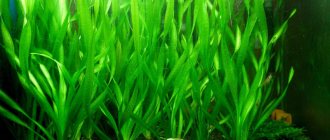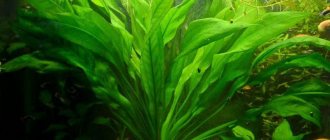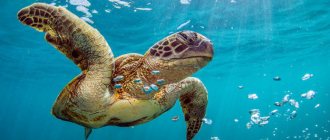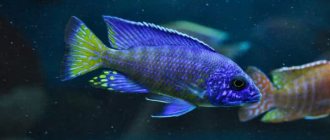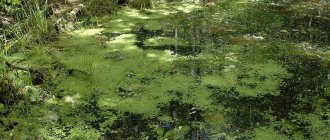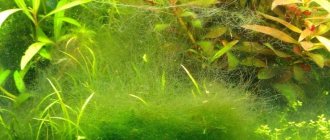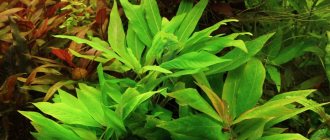A beautiful and healthy aquarium cannot be imagined without aquatic plants. They not only serve as decoration, food and shelter for the fish, but also maintain balance in the tiny closed ecosystem of the tank. In this article we will look at the most common algae in the aquarium: types, photos and names.
Algae as a biological group
Botanists include photoautotrophic (receiving nutrients independently thanks to light energy) unicellular, colonial and multicellular organisms to the group of algae. These types of living things usually live in a humid environment: in water, soil, drops of moisture in the atmosphere. The science that studies algae is called algology.
Botanical description
Different groups of algae are strikingly different from each other. Single-celled representatives can resemble amoebas, have flagella, cilia, and form colonies. Higher algae have tissue—thallus—reminiscent of that of higher land plants. The so-called “false tissues” can take the form of plates, siphons, tubes, threads.
As a rule, these creatures do not have roots: there are only their similarities - “rhizoids”, which serve only to attach the body to the substrate, and not to absorb minerals. Several types of reproduction are characteristic at the same time: vegetative (pieces of tissue), asexual (spores) and sexual.
Physicochemical characteristics
Research institutes are studying the chemical properties of sea greens in detail. When dried, it can be easily dried for grinding to the smallest particles. Ocean grass is rich in extractives, mineral elements, nitrogen-containing elements, carbohydrates, and lignin. There are very few ether-soluble particles in it.
All marine plants have high ash content and accumulate minerals well. The grass has a good balance of macro- and microelements. There is a piggy bank of B vitamins, carotene, ascorbic acid and other substances.
General classification
Greens
This group includes the least developed representatives. The bulk of species are represented by solitary and colonial unicellular organisms; some multicellular organisms have a primitive structure - a “thallus”.
Currently, this department is considered the most widespread and most studied. A definite number is still unknown: new species are discovered every year! According to rough estimates, there are from 13 to 20 thousand green algae.
They live in all corners of the globe. They are eaten and used as bioindicators of the state of the environment. A number of genera are pests. The department is characterized by all kinds of reproduction and development cycles.
Brown
They are the most developed of all leaders. They are characterized by multicellularity, patterns of stage changes, and developed sexual and vegetative reproduction. Their body most closely resembles plant tissue. Most often they live in sea water at shallow depths - up to 40-100 meters. They occupy an important place in the aquatic ecosystems of the ocean.
Many species are protected, especially those living in the Galapagos Islands. They are used as food in many countries of East Asia, and they are no less important for science - it was on brown algae that humanity learned to sequence the genome.
Reds
The smallest group. Most species live in sea water, only a few live in fresh water bodies and soil. These algae can produce chlorophyll only at shallow depths, so they do not settle deeper than 50 meters. They are typical representatives of the bottom (benthic) vegetation of the coasts. There are approximately 7,500 species.
Agar-agar is made from them. They are the most demanding algae, so they are quite difficult to grow under artificial conditions. The oldest fossil found to date is a specimen of red algae, mined from rock in Canada.
Blue-green
Otherwise they are called Cyanobacteria. It is a mistake to call these creatures algae - they belong to ordinary bacteria capable of photosynthesis and releasing large amounts of oxygen. They are closest to ancient proto-organisms that went extinct billions of years ago. They can have different shapes, types of development and methods of reproduction. They are united only by the absence of flagella and the presence of a protective mucous membrane.
In aquariums and natural reservoirs, such bacteria are parasites that can lead to the death of fish. Normally, there are few cyanobacteria, but during environmental disasters (the application of fertilizers and pesticides), they multiply so actively that they produce substances that are fatally toxic to all aquatic animals.
Light, depth and transparency of water
These three interrelated factors influence the growth and reproduction of eelgrass, since all plants require a special light regime for photosynthesis and growth.
The amount of sunlight decreases as depth increases and also depends on the clarity of the water. Turbidity affects plant growth by significantly reducing light penetration - a major factor in the decline of seagrass meadows.
Around the British Isles the grass usually grows at depths of up to 4 m, but can spread deeper in some places. In the clearest waters of the Bay of Ventry in the southwest of Ireland, eelgrass is found in depths ranging from 0.5 to 10 m, and in some areas to a maximum depth of 13 m.
On the northwestern American coast, the maximum depth for plant life is 6.5 m. However, in the extremely clear water off the coast of California, eelgrass grows at depths of more than 30 m.
Seagrass grows in estuaries, bays, lagoons and other marine environments where the water is clear, light is plentiful and the bottom is sandy. Prefers calm waters, but can also grow in fast currents.
Negative impact
Algae is dangerous for the aquarium. Many people who are far from aquarium hobby confuse this department with aquatic plants. We will list the main differences in the next section of the article.
Which species are dangerous?
The most common parasites in an aquarium are green, brown algae and cyanobacteria.
The most dangerous representatives:
- black beard;
- flip-flop or deer antlers;
- filamentous – the so-called “thread”;
- Cladophora;
- spirogyra;
- xenococus - that very “green coating”;
- blue-green (unite many Families, reminiscent of turquoise, greenish-blue or jade threads and moss).
All these representatives belong to the protozoa: unicellular or colonial. They grow at a catastrophic speed, taking nutrients from the water and leading to oxygen oversaturation, causing illness and death of fish and arthropods. Sometimes the entire wall and soil can be covered with a carpet of their protozoa.
Why do they lie in the aquarium?
The reasons for the appearance of these creatures can be different, but are most often associated with improper care of the aquarium and poor water quality.
Main reasons:
- Incorrect lighting (use of lamps of inappropriate power and spectrum, excess lighting, too long or short daylight hours).
- A large amount of dead organic matter, waste and other debris.
- Malfunction of the filter, aerator (compressor) and other equipment.
- Infection with purchased plants and fish from other aquariums.
- Disturbances in the balance of the mini-ecosystem due to the introduction of fertilizers, antibiotics and other unusual chemicals into the water.
Most of these causes can be eliminated at the very beginning of their manifestation if you properly care for the tank and its inhabitants.
How to get rid
If the aquarium is overgrown with green algae, you need to take drastic measures immediately. To prevent the water from “blooming” and new brown algae appearing, it is necessary to take a number of measures.
These include:
- standardization of light conditions;
- water change;
- troubleshooting equipment;
- combating with the use of special chemicals that suppress the development of algae and bacteria - use only in extreme cases.
It is very important to dose fish food correctly so that the food does not decompose and turn into nitrates, which provoke the rapid development of protozoan plants.
Prevention methods
It is always easier to prevent a problem from occurring than to think about ways to solve it later.
To prevent algae from appearing, it is enough to follow a number of simple rules:
- normalize the light regime - no more than 12 hours a day;
- regularly check the performance of the filter;
- clean the aquarium on time;
- quarantine new animals and plants after purchasing even from a trusted breeder or pet store.
Experienced aquarists advise familiarizing yourself with the basics of ecology in order to know what processes in aquatic systems are interconnected, and what the disruption of one link can lead to.
Use in industry and agriculture
Sea greens are a feed additive for sheep, pigs, and cattle. The milk yield of cows fed a diet of sea grass increases per day by 15-20%, and fat content by 0.35%. In this case, no additional odors are detected in the milk. Poultry that feed on these plants lay more hard-shelled eggs. The use of sea grass for the production of compound feeds enriches their composition with vitamins by 40%.
Some confectionery associations use sea green pectin as a substitute for citrus extract (for marshmallows and marmalade). Also, grass from the sea allows you to make high-quality paper. It is noteworthy that such paper almost does not burn.
Differences between algae and aquatic plants
Beginners often mention so-called “healthy algae”. Unfortunately, there are no such things. What many call algae are aquatic plants - with real roots, stems and leaves. Some species have adapted to life in water, while others can live on land at the same time, producing several stems above the surface.
Let's look at the main differences between these two groups:
- Algae are the lowest form of life. They do not have full-fledged organs, multicellular individuals are not divided into real tissues - their cells are copies of each other.
- Algae reproduce by spores and cannot have flowers or seeds, like conifers. Higher aquatic plants do not have spores.
- Only real plants have roots, leaves, stems, and flowers.
Therefore, all decorative aquarium “algae” actually do not belong to this group.
Zoster sea grass
Zostera marinea is a perennial sea green plant with a branched root system and tall grass. It is also called eelgrass or kamka. The entire Black Sea coast is overgrown with this plant. It is also found in the Azov, Caspian, White and Far Eastern seas.
Eelgrass is used to fill pillows and mattresses; sleeping on them is useful for respiratory diseases and disorders of the nervous system.
Zoster is abundantly washed ashore by storms. Then they collect it. Special nets are made for this. Then it is dried and crushed. Processing of raw materials may vary.
Useful types
Before deciding which algae is best to purchase for an aquarium as soon as possible, you need to study the entire list of species suitable for keeping. Below are the most popular types of aquarium plants, photos and descriptions of each representative.
Duckweed
A small floating plant that lives on the surface of the water. The leaves are bright green, small, round or oval, and contain air chambers on the underside that keep the plant afloat. The stems are very short, occasionally exceeding two millimeters.
The plant is light-loving, perennial. It can be added to the aquarium for decorative purposes, as food for fish and building material for Labyrinth and Cichlid nests. Duckweed is very unpretentious and can live in a wide range of temperatures, hardness and acidity. Universal look for any tank.
Vallisneria
One of the most popular genera. Most often, three species are planted: spiral Vallisneria, giant and dwarf. The leaves of the bush are bright green, thin and long, can reach 70-80 centimeters.
Requires the following conditions:
- temperature +22-28 °C;
- hardness is very low – up to 8 dH;
- acidity 6-7.5 pH;
- layer of soil from 3-4 for a dwarf to 7-8 for a giant variety.
It is strictly forbidden to trim the leaves - they will begin to rot and may even die. Shoots should only be removed by plucking the daughter bushes.
Elodea
Used exclusively for decorative purposes, the birthplace of the species is North America. In the wild, it lives in swamps, lakes, ponds and rivers with weak currents. The leaves are lancet-shaped, about 1-1.5 centimeters long, bright green. The stems themselves can grow up to two meters.
Conditions of detention:
- hardness from 2 to 14 dH;
- acidity – 5.5-8 pH;
- cool water +16-24 °C;
- daylight hours – 12 hours.
Can live in any type of soil. Survives in shade and well-lit areas.
Hornwort
One of the most popular and unpretentious plants. The growth of representatives of the species is unlimited. The stem is thin and elastic, the leaves are rich green, needle-shaped. Works as a “filter” in the aquarium, removing suspended matter, nitrates and producing oxygen.
Hornwort is absolutely unpretentious and can live in a wide range of hardness, acidity and temperature from 20 to 30 °C. The water needs to be changed a quarter once a week; this type of plant does not require more.
Limnobium
It grows in water bodies of North and South America in tropical and subtropical latitudes. The leaves are glossy, green, round (reach 2-3 centimeters in diameter), float on the surface of the water. The plant in the aquarium is very often used as a source of shade for shade-loving fish. The algae loves soft (10-12 dH), warm (+23-30 °C) and slightly acidic (6.5-7 pH) water. It reproduces very quickly by lateral shoots; as the temperature drops, it does not die, but stops growing.
Riccia
It grows in all warm temperate regions of the globe. It resembles openwork moss of bright green color with thin, slightly flattened leaves. The species is used as a shader in an aquarium and a natural “nest” for eggs and fry. It is a thermophilic species, therefore it stops growing at temperatures below +20 °C, the ideal temperature is 23-26 °C. Loves slightly alkaline or neutral soft water.
Java moss
A favorite of many aquarists. Southeast Asia is considered its homeland. The plant is unpretentious, grows slowly, but all year round, regardless of conditions. The hardness and acidity of water have absolutely no meaning - Java moss is truly extreme in this regard.
Moss is more demanding of temperature - the most favorable range is +24-28 °C. It can grow even with minimal lighting, but does not tolerate cloudy water, although it does not require frequent replacement. It does not require soil: it can grow on any substrate and even on the surface of objects.
Cryptocoryne
At home - in Southeast Asia - it can grow in standing reservoirs, rivers and even sea coastal areas. Equally tolerant of salt and fresh water. Loves dim, soft lighting most of all. The names of algae may differ slightly; the list is presented below.
There are many types, the most common include:
- undulata;
- Thwaiteza;
- heart-shaped;
- spiral;
- related;
- purple;
- ciliated;
- parva;
- Neville;
- Griffith;
- Beckett;
- Welker;
- Albida.
All species require similar conditions and, especially, a temperature of +24-28 °C. The rapid overgrowth of soil by bushes is limited by the temperature characteristics of the water.
Echinodorus
Perennial marsh grass for the aquarium. The leaves grow directly from the rhizome; bushes most often reproduce by budding. The leaves are very dense and elongated, and can be of different shapes: spear-shaped, pointed, oval, elliptical. The plant has real flowers, leaves and branches grow on the peduncle. The bushes are large (60-65 centimeters), so they are planted in large aquariums. Small granules are not suitable: fine gravel and coarse sand are preferable.
The water should be soft (5-10 dH), cool (+18-25 °C), neutral in reaction (6.5-7.5 pH). There are many hybrids of this species, for example, Echinodorus angustifolia, cordifolia Tropica Marble Queen, tender, Blechera (yarrow), ruby, Rose, Amazonian.
Ludwigia
Most often grows in the tropics and subtropics. The bulk of the Fireweed family, numbering 75 species, lives on land, only some species “fall” under water. The most common are arcuate, swamp and creeping ludwigia.
Habitat conditions of the species:
- temperature – 20-28 °C;
- bright lighting;
- any hardness is acceptable, increased (more than 8 dH) even gives brightness to the leaves;
- acid-neutral environment;
- The root system is poorly developed, so sand is most suitable as a soil.
May be red, green, yellow. The flowers are small green, the bushes rarely grow above 30-35 centimeters. The leaves are flattened, diamond-shaped or teardrop-shaped.
What is Eelgrass?
Zostera grows underwater in estuaries and shallow coastal areas. This flowering plant can live for many years, that is, it is considered a perennial, although annual forms also exist. Sea grass is present in the subtidal zone throughout its entire life cycle (flowering, pollination and seed germination).
Eelgrass is a primary food source for many plants and animals, as well as a home for shellfish, including crabs, lobsters and fish. The plant filters pollutants from the water column, is a key component of the nutrient cycle, and also protects shorelines from erosion, wave energy and storms.
Eelgrass forms large meadows or small isolated beds that range in size from a few acres.
Green shoots extend upward from the central stem of the plant. The rhizomes are fleshy and grow horizontally to the surface.
Eelgrass is a seasonal plant; it dies off in winter and blooms again in spring and summer. Growth depends on many factors: physical and chemical disturbances, nutrient availability, changes in water quality parameters such as turbidity and salinity.
Light is a key factor in determining seagrass growth limits. The maximum depth at which the plant grows depends on the availability of suitable substrates, acceptable flow rates and light penetration. Water turbidity negatively affects light transmission.
The plant has an extensive network of branching, creeping underground roots that help bind sand or dirt into the substrate. These horizontal rhizomes bear leafy shoots with abundant green leaves that look like grass. The leaves are flat and linear, with maximum length and width varying depending on the species.
Leaves have large air spaces (lacunae) between the cells that act as buoyancy chambers and keep the leaves upright in the water. There are small, inconspicuous flowers that are collected in inflorescences. Male and female flowers exist separately, but are also found on the same plants.
How to maintain conditions
Most aquarium plants are unpretentious, which is why they have earned such wide popularity.
The following rules must be followed:
- regularly feed the bushes with fertilizers;
- follow the rules for creating optimal daylight hours;
- adjust water parameters using special devices and indicators;
- choose the appropriate type of soil for a specific type of plant;
- Place fish species compatible with plants in the aquarium.
It is important to rely on previous experience, so if you are a beginner, it is better to choose the most unpretentious plant species.
Consumer Reviews
Many buyers leave grateful reviews after purchasing furniture filled with sea grass. People note that this plant has a healing and antibacterial effect because it releases iodine. Sleeping on orthopedic damask mattresses charges you with energy for the whole day. This is a kind of natural latex, which is obtained by impregnating and bonding ocean grass. Mattresses made from this material have a light massage and soothing effect, regulate the balance of humidity and temperature of the sleeper.
Algae as fish food
Some types of fish are not averse to eating tasty algae and aquatic plants. In some cases, this behavior of pets is undesirable, in others, on the contrary, it helps to cope with attacks of “black beard” or “green plaque”.
Let's name the most famous algae eaters:
- Chinese algae eater;
- Molly sphenops and closely related viviparous species;
- Florida or American flag fish;
- Siamese algae eater;
- cleaner catfish;
- ancistrus (he prefers to eat wood and dense crust on the stems of aquatic plants).
Most of all, fish like to feast on hornwort, duckweed, valisneria, Java moss, riccia and similar plants with soft, succulent leaves.
Don’t expect any fish to help get rid of a cyanobacteria infestation, because they are extremely dangerous for all animals, because they secrete special algotoxins.
Ocean grasses: features
Sea grasses and algae grow in vast underwater “meadows.” The shallow waters are simply overflowing with them. These plants are absent only in Antarctica, the Arctic, the eastern Atlantic, South America and New Zealand. A number of species have wide habitats.
In silt, sand and loose soil, sea greens are anchored by rhizomes. What they love most is muddy sand. Some species like rocky surfaces. But representatives of Phyllospadix can resist surf and strong currents. Drought does not threaten the sea meadows, unless there is a strong low tide.
Pollen from plant flowers is carried by water, which is why their method of pollination is called “hydrophily.” Birds feed on sea green seeds.
Biological balance
Achieving complete biobalance is difficult, but possible. Normally, a reservoir, like a large natural reservoir, must maintain the circulation of substances. All dead remains must be broken down by beneficial bacteria and reduced to substances that can be consumed by plants, then produce energy through photosynthesis and again produce biological matter - most often starch and saccharides. Next, the fish eat the plants, digest them, build their bodies from amino acids, produce waste, and the process begins again.
Nitrifying bacteria are responsible for this balance. We will not fully describe the processes produced by these microorganisms: it is so complex that it deserves a whole series of articles. In nature, everything is harmonious, so the balance is established by itself, our task is just not to disturb it inadvertently or intentionally.
Salinity of water
Mature plants are well adapted to changes in salinity. Optimal salinity is 10 - 39 ppm. Subtidal populations of the plant that are not exposed to reduced salinity produce few or no reproductive shoots.
It has been proven in laboratory conditions that maximum germination of zoster occurs at 1 part per thousand salinity. Surprisingly, this is a low salinity indicator, since eelgrass is found even in completely saline conditions.
However, field studies indicate that its germination occurs over a range of temperatures and salinities.
